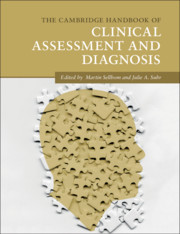Book contents
- The Cambridge Handbook of Clinical Assessment and Diagnosis
- The Cambridge Handbook of Clinical Assessment and Diagnosis
- Copyright page
- Contents
- Figures
- Tables
- Contributors
- Acknowledgments
- 1 Introduction to the Handbook of Clinical Assessment and Diagnosis
- Part I General Issues in Clinical Assessment and Diagnosis
- Part II Specific Clinical Assessment Methods
- Part III Assessment and Diagnosis of Specific Mental Disorders
- 21 Assessment of Childhood Neurodevelopmental Disorders
- 22 Assessment of Childhood Disruptive Behavior Disorders and Attention-Deficit/Hyperactivity Disorder
- 23 Assessment of Depressive Disorders and Suicidality
- 24 Assessment of Anxiety Disorders and Obsessive-Compulsive Disorder
- 25 Assessment of Trauma- and Stressor-Related Disorders
- 26 Assessment of People with Psychotic and Bipolar Disorders
- 27 Assessment of Eating Disorders
- 28 Assessment of Substance Use Disorders
- 29 Assessment of Personality Disorder
- 30 Neuropsychological Assessment of Dementia
- 31 Assessment of Traumatic Brain Injuries
- Part IV Clinical Assessment in Specific Settings
- Index
- References
24 - Assessment of Anxiety Disorders and Obsessive-Compulsive Disorder
from Part III - Assessment and Diagnosis of Specific Mental Disorders
Published online by Cambridge University Press: 06 December 2019
- The Cambridge Handbook of Clinical Assessment and Diagnosis
- The Cambridge Handbook of Clinical Assessment and Diagnosis
- Copyright page
- Contents
- Figures
- Tables
- Contributors
- Acknowledgments
- 1 Introduction to the Handbook of Clinical Assessment and Diagnosis
- Part I General Issues in Clinical Assessment and Diagnosis
- Part II Specific Clinical Assessment Methods
- Part III Assessment and Diagnosis of Specific Mental Disorders
- 21 Assessment of Childhood Neurodevelopmental Disorders
- 22 Assessment of Childhood Disruptive Behavior Disorders and Attention-Deficit/Hyperactivity Disorder
- 23 Assessment of Depressive Disorders and Suicidality
- 24 Assessment of Anxiety Disorders and Obsessive-Compulsive Disorder
- 25 Assessment of Trauma- and Stressor-Related Disorders
- 26 Assessment of People with Psychotic and Bipolar Disorders
- 27 Assessment of Eating Disorders
- 28 Assessment of Substance Use Disorders
- 29 Assessment of Personality Disorder
- 30 Neuropsychological Assessment of Dementia
- 31 Assessment of Traumatic Brain Injuries
- Part IV Clinical Assessment in Specific Settings
- Index
- References
Summary
The current chapter reviews assessment of anxiety disorders and obsessive-compulsive disorder in adults for answering clinical questions about diagnosis and severity of the anxiety disorder; case formulation and treatment planning; monitoring of progress throughout treatment; and measurement of treatment outcome. Evidence-based assessment of adult anxiety disorders includes the use of semi-structured diagnostic interviews, self-report measures (questionnaires), clinician-rated measures, and behavioral assessment techniques. The current chapter necessarily reviews only the most prominent tools used for assessment of adult anxiety disorders. For each anxiety disorder discussed in this chapter, we review assessment methods and recommend an assessment battery that would include a structured diagnostic interview, a brief measure of severity that can be administered throughout treatment to monitor progress, and a selection of measures (e.g., a self-report measure and a behavioral assessment) that allows for case formulation and tailoring of evidence-based treatment to the client’s individual needs.
- Type
- Chapter
- Information
- The Cambridge Handbook of Clinical Assessment and Diagnosis , pp. 330 - 346Publisher: Cambridge University PressPrint publication year: 2019



